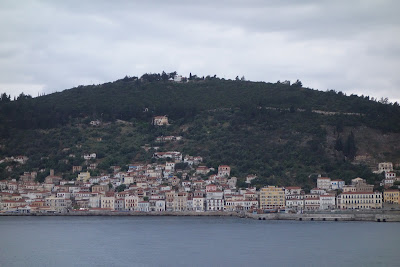ATHENS
To put a locational stake in the ground, our itinerary starts
its final leg of the trip in Athens. You
know, the home of the Acropolis …
the Parthenon …
(Madeline, this is Athena's house)
the Erechtheion with its porch of caryatids …
and friends, Greek sun, beer, wine and food *.
(* Actually I took some artistic liberty here ... aka alternative facts. This photo is taken from the isle of Patmos, Greece located in and overlooking the Aegean Sea on the way to Athens. A wedge of spanakopita for the first person to name the book of the New Testament and its credited author who died in prison on this island.)
But our travels this time did not begin in Athens, they
began in Mycenae. But before we go there
a word about the southern part of the mainland – the Peloponnese. I decided to group several days of travels
into this one blog to both discuss the entire southern region and get caught up
on the blogs. So bear with me, this will
be a bit longer than usual.
The area to the east faces the Aegean Sea; the area to the
west faces the Ionian Sea. In between, the Peloponnesian War took place (431-404
BC) and reshaped the ancient Greek world.
Athens, the strongest city-state in Greece prior to the war's beginning,
was reduced to a state of near-complete subjection, while Sparta became
established as the leading power of Greece. This changed much later as Sparta
was completely defeated.
The Peloponnese and Athens
in particular has been subjugated by many conquering nations. But as our guide said, no matter, Greece
exported love not war. She reminded us
that at the center of Greek culture was the human being and the arts. Greece offers philosophy, drama, and
sculptures representing the human form. And as our priest, Becky, reminded us
at Easter, love wins.
MYCENAE
Mycenaean Greece represents the first advanced civilization on the mainland with its urban organization, works of art and writing system.
For those of you who attended architectural school, you’ll remember
the Lion Gate of Mycenae from a 7:30 a.m. ancient civilizations history class. You
know, the slide just before you fell asleep in the darkened theater after a design
class all-nighter.
The Lion Gate was the main entrance of the Bronze Age citadel of Mycenae and
located on the northwest side of the acropolis.
With the use of the lions (likely
a Sphinx with a head of different animal/material), it symbolized the power the Mycenaean kings to both subjects and foreigners.
Just to the right as you enter the
fortifications you’ll see Grave Circle A.
This is odd because like Grave Circle B and others, these cemeteries are
normally found outside of the fortifications. Seems that A was for the royal families.
The Lion Gate was erected during the 13th
century BC about the same time as Pharaoh
Akhenaten ruled Egypt … remember him? I
mention this because the gold for the crowns of the Mycenaean kings, found in the Circle A
site came from Egypt in exchange for their assistance in the Egyptian Army.
CORINTH
Anchored by the Temple to Apollo …
the ancient Greek City State of Corinth stands
about half way between Athens and Sparta.
Ancient Corinth was one of
the most important cities of Greece, with a population of 90,000 in
400 BC. Not only did it give
us the Corinthian order of Greek Architecture *…
(* Look closely on the ground and you'll see the capitals.)
it also gave
us the concept of the agora of Greek urban
planning and the context for Paul’s letters
to the Corinthians.
Imagine if you will the foundations in front (i.e.,
to the right) supporting the columns to support the porticoes of stores to the
left.
Now imagine all of the merchants shouting out their wares for sale, as the
shoppers wandered under the shade of the roofed enclosures. And all of this activity organized around a
large open plaza for public interaction known in Greece as the agora. Which, by
the way, was the same urban planning model found on the Temple Mount in Jerusalem.
The Romans demolished
Corinth in 146 BC, and built a new city in its place in 44 BC, and later made
it the provincial capital of Greece.
Known as the ancient Las
Vegas (alternative fact) Corinth was in
fact known for its night life and one reason it was so attractive for St. Paul
to visit. Maybe I should rephrase that,
but you know what I mean. It was pretty amazing
to stand on the spot where, after an 18 month stay, Paul was put on trial in
the forum (Roman name for the Greek “agora”) by Gallio, the proconsul of Achaia. If you want to find out what happened go to Acts 18: 12-16.
Tune in to Greece
– The Peloponnese, From Athens to Sparta Part 2















































